When Southampton famously lost by nine goals to nil at home against Leicester City earlier in the season, they sat 18th in the table after 10 games. The horror start left many wondering whether Ralph Hasenhüttl would be able to keep his side in the Premier League and had others questioning the manager himself. However, the thumping they received at home served as an important wake-up call and though Southampton were just three points ahead of the relegation zone halfway through the season, they finished in 11th, 18 points clear of relegation and seven behind the top six. The Saints recorded some shock results along the way, beating Manchester City, Chelsea, Leicester and Tottenham while also claiming a point away at Arsenal and Manchester United. Hasenhüttl’s side looked much better offensively and Southampton could have possibly finished higher had it not been for their relatively shaky defence. An improved backline would almost certainly mean that the Saints could push higher next season and in this data analysis, we will be looking at statistics across the top five leagues in Europe to find a centre-back that could fit Southampton.
We shall begin our analysis by understanding the playing style of the Southampton centre-backs so that we will be able to identify key metrics to look for in our data analysis. In order to do this, we will look at an example from their game against Arsenal at home, where they lost 2-0 largely due to errors at the back although they looked the better attacking side.
Analysis of Southampton centre-backs
Hasenhüttl has frequently opted to play a 4-4-2 formation and has looked to channel most of his attacks down the wing. The likes of Nathan Redmond and Stuart Armstrong move forward to join the forward line an effectively create a front four. The full-backs, usually Ryan Bertrand and Kyle Walker-Peters, would then move forward to occupy the winger role, maintaining a four in midfield along with James Ward-Prowse and Pierre-Emile Højbjerg
This meant that the initial 4-4-2 formation was now a 2-4-4 set-up and the centre-backs had to ensure that they could cover any quick counter-attack. The only aid they received was from the two in midfield who would play as double pivots and drop back to receive the ball from the centre-backs. Such a formation was very effective in the attacking phase as shown below.
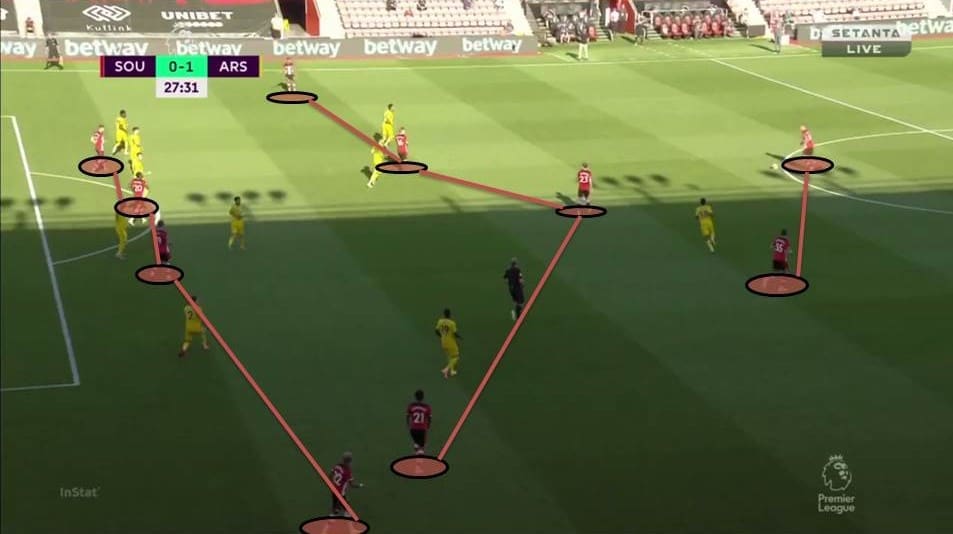
Southampton were able to pile the pressure with their tactics and forced the opposition back towards their own goal. The centre-backs especially could stay in the opposition half and were effectively playing as deep-lying playmakers. Their position so high up the pitch meant that they were crucial in starting the attacks and would dictate the channel by which the Saints would attack. They could play the ball down the centre to their supporting midfielders or switch the ball between wings where the Southampton forwards would look to create overloads.
This shows that apart from their defensive duties, the centre-backs need to be good on the ball and have good passing abilities. They would usually never push further than the midfielders and hence, progressive runs and their dribbling ability are not as important.
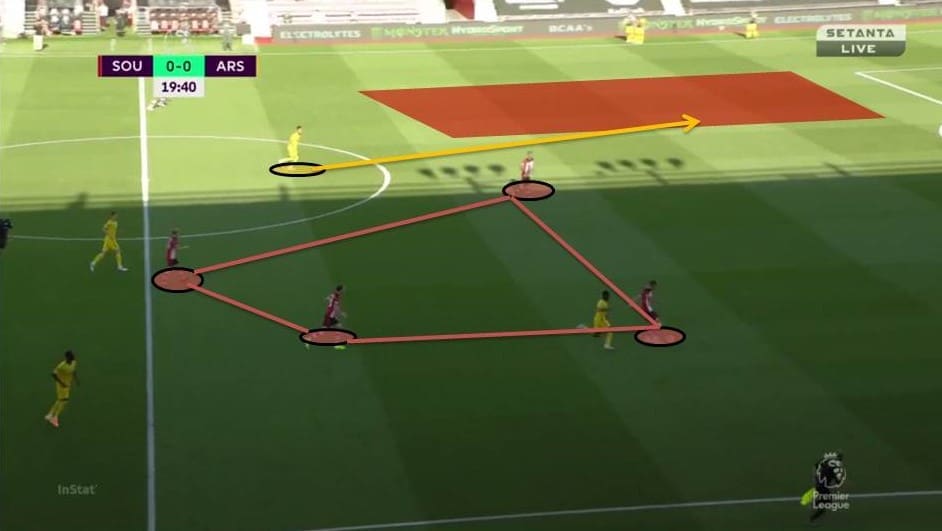
When it comes to their defensive duties, however, we see a few issues arise. The 2-4-4 formation means that Southampton are open to counter-attacks down the wings due to the massive gaps left there and even with the full-backs and midfielders falling back, they are unable to deal with these counters. Moreover, the centre-backs look uncomfortable on the ball as well. When playing against a high-press, the centre-backs see their passing options reduced due to the higher positions of the full-backs and this effectively means that they can only communicate with the midfielders and goalkeeper.
Such a strategy is not very effective in getting the ball past the press and long-balls would probably be the most suitable way for the centre-backs to progress the ball. The current centre-backs have not been the best in doing this though and have been caught out due to their lack of passing ability. Against Arsenal, two defensive errors lead to goals for the Gunners and this was due to the centre-backs not being correctly positioned to deal with the press as well as not being quick enough to pass the ball to evade the press.
It is evident that the high-risk strategy employed by Hasenhüttl will require the centre-backs to deal with such quick attacks and in this case, interceptions and blocking shots would be key. They generally give us an idea of the ability of the centre-back to read the game and position himself well and hence, on top of passing, this would be something to look for as well.
Analysis of Southampton’s transfer activity
Before we jump in to find a centre-back for the Saints, we should first look at their transfer activity over the past five years in order to get a better idea as to the type of players that they sign. Below is the data of Southampton’s recruitment trends over the last five years.
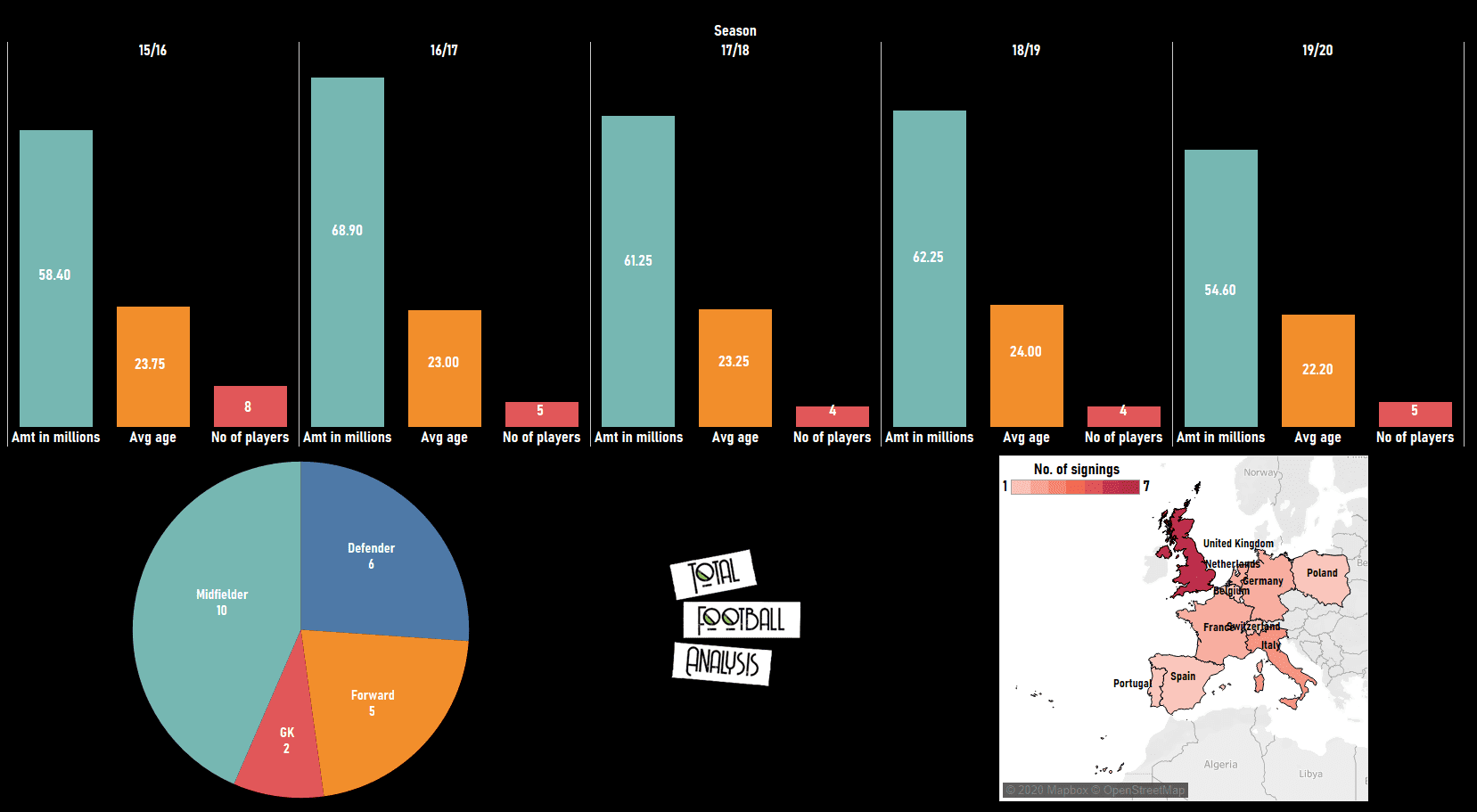
We see that the club spent at least around 55 million euros in each of their last five seasons with the 68.90 million that they spent in the 2016/17 season being the highest during this period. The average age of the players signed never crossed 24 as well, indicating that the club likes to sign players who are considered youth or just entering their peak age. In fact, the oldest players as of signing during this five-season period were aged 26, meaning they still had a few years left in their peak age range.
Majority of the signings were also from England, with seven players signing from there as well as three players signing from Scotland, giving a total of 10 players from the United Kingdom. The next highest number was from Germany and Italy with three players each signed from these countries. France was next with two along with the Netherlands while Belgium, Switzerland, Poland and Spain all had one player each.
Hence, our decision to find a centre-back from the top five leagues in Europe is not far off from the trend of Southampton and this means that we have identified the correct set of players for our data analysis.
We should note, however, that majority of the signings were midfielders while about a quarter of the signings were defenders. Out of the six defenders signed permanently, four were centre-backs and only two remain at the club. The highest signed defender cost about 25 million euros and this is the limit that we will use as well.
With the information above, we will limit our data analysis to centre-backs in Europe’s top five leagues that are aged 27 or lower and have a maximum market value of 25 million euros. We will further narrow down our list by taking only those players that have played a minimum of 600 minutes in the 2019/20 season to ensure reliable data for our analysis. Our list is now down to about 150 players across Europe and we will move onto analysing the statistics for these players.
Data analysis as per Southampton’s requirements
The colours of the players’ markings have been made according to which metric they feature highly in. This is done so that we may keep track of players who have done well in certain areas and identify better if they have done well in the other metrics as well. We aim to find a few centre-backs who appear highly in a few metrics and at least decent in the others so that we may select standout overall options for Southampton.
The metrics that we will look at are:
- Defensive duels (defensive duels per 90 vs success rate)
- Aerial duels (aerial duels per 90 vs success rate)
- Positioning (PAdj interceptions per 90 vs shots blocked per 90)
- Progressive passes (progressive passes per 90 vs success rate)
- Final third passes (final third passes per 90 vs success rate)
- Fouls per 90
The colour codes are given below:
Green – Players ranking highly primarily in defensive duels
Blue – Players ranking highly primarily in aerial duels
Pink – Players ranking highly primarily in positioning
Orange – Players ranking highly primarily in final third passes
Brown – Players ranking highly primarily in progressive passes
Red – Other players who do not feature unless stated otherwise
We shall now dive into our data analysis and by the end of it, we hope to have found the best available options for Southampton according to the statistics.
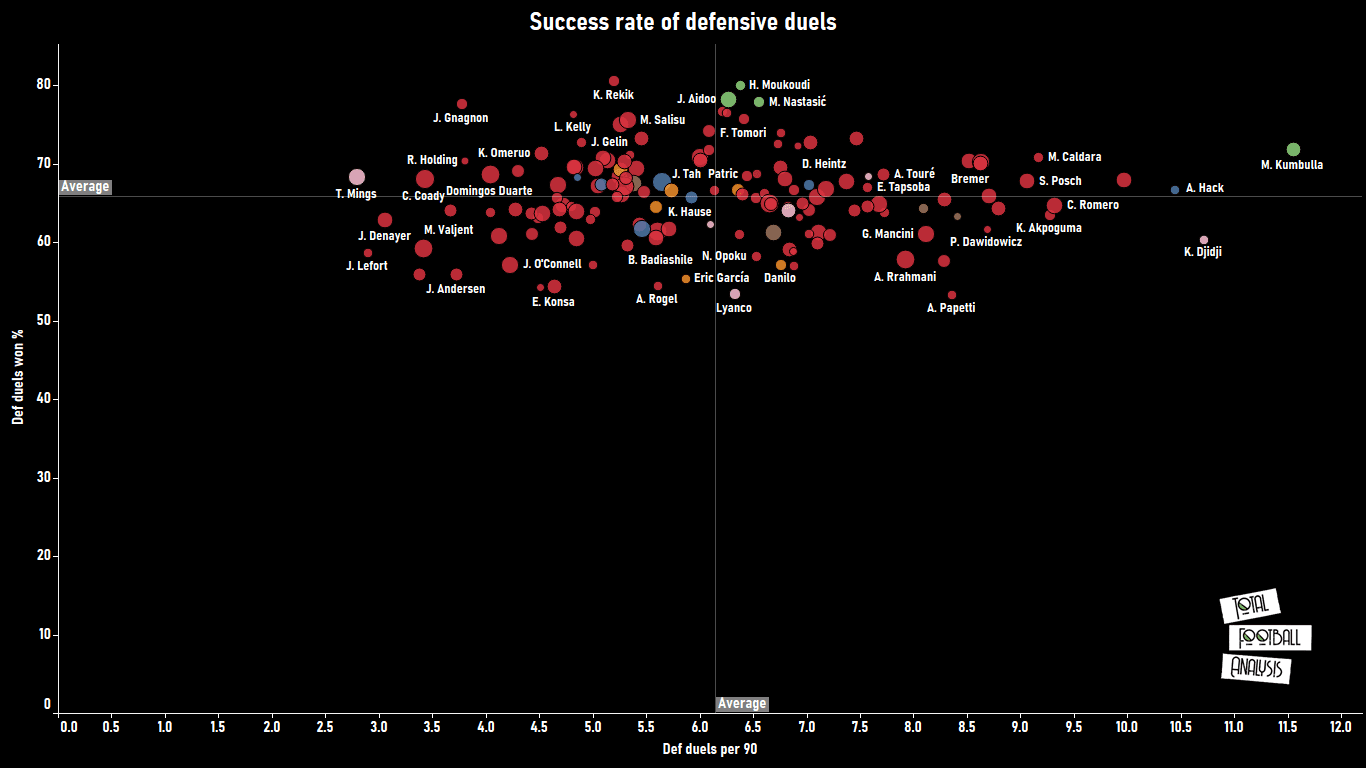
We start our data analysis by looking at the statistics for defensive duels. The size of the player markings has been adjusted for minutes played with the minimum being 600 minutes as mentioned earlier. Looking at the statistics, we see that Marash Kumbulla of Hellas Verona has the highest number of duels per 90 (11.55) along with an above-average success rate (71.80%). The 20-year-old has played just over 2000 minutes this season and has already caught the eye of a few big clubs like Inter Milan, Lazio and Arsenal but with his market value, Southampton could join the bidding as well.
When we look at the standouts in terms of success rate, AS Saint-Étienne’s Harold Moukoudi has been impressive. The 22-year-old has engaged in an above-average 6.38 defensive duels per 90 and has a success rate of 80% playing about 1000 minutes this season. He is followed by Celta de Vigo’s Joseph Aidoo who has engaged in about 6.27 defensive duels per 90 with a slightly lower success rate of 78.19% in around 2600 minutes last season. Schalke’s Matija Nastasić follows them with his 6.56 defensive duels per 90 and 77.88% success rate. The 27-year-old is one of the older players on our list but in just about 1400 minutes, does have decent statistics. His experience may prove handy for Southampton in the Premier League as well.
Apart from those above, we see Mainz’s Alexander Hack and Torino’s Koffi Djidji who feature highly in terms of defensive duels per 90 but not so much in their success rate. These players will appear in the later metrics of our data analysis as well.
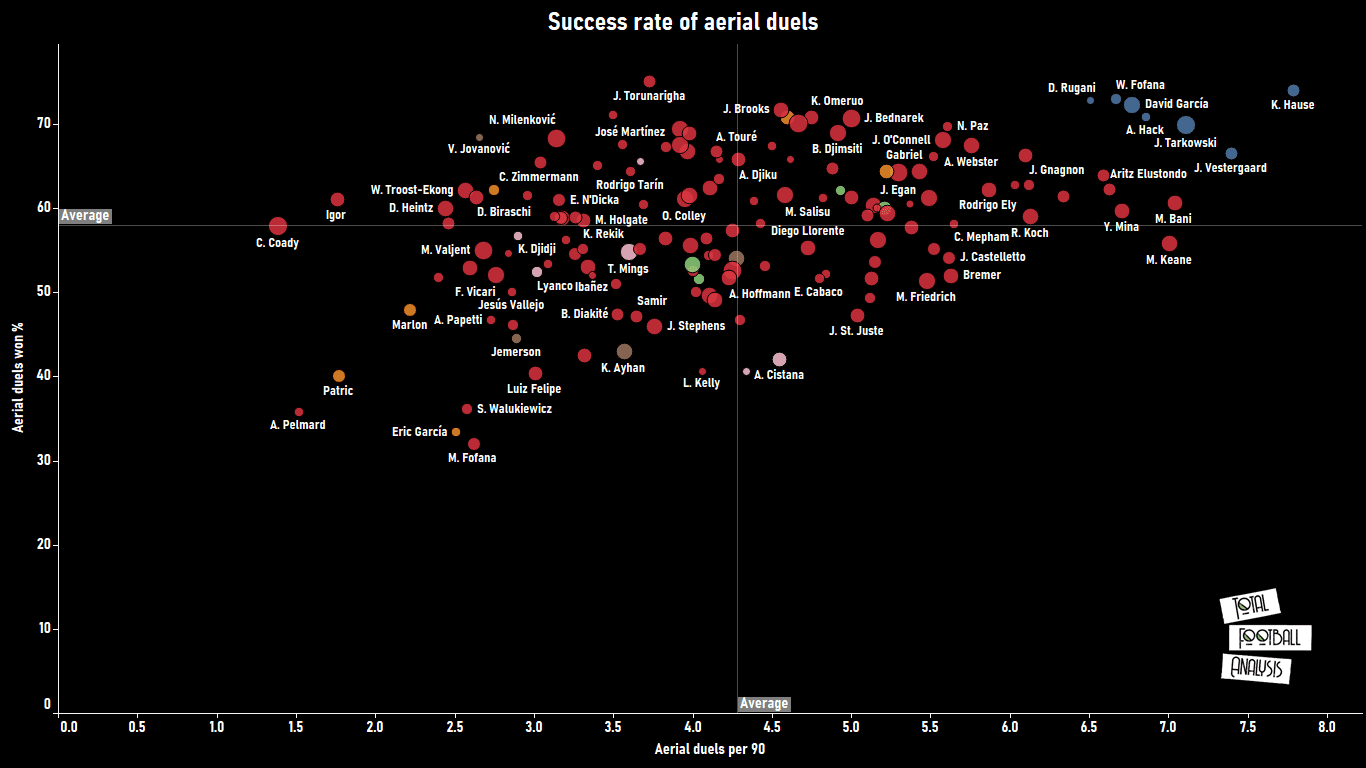
Another crucial metric we would have to look at is the aerial duels. With Southampton’s style of play, we can expect teams to play balls over the top to launch quick counters and the centre-backs should be good in the air. When we look at the statistics, we see that Aston Villa’s Kortney Hause is a standout performer with about 7.79 aerial duels per 90 with a success rate of 73.97% in around 1700 minutes last season. Interestingly, we also see Southampton’s Jannik Vestergaard have the second-highest number of aerial duels as well. His teammate Jan Bednarek also engages in an above-average number of aerial duels and this highlights the fact that the Saints need centre-backs capable in the air.
We see Hack (6.86 aerial duels/90 and 70.77% success rate) featuring highly here as well with his considerably lower minutes (853). Burnley’s James Tarkowski also ranks highly with his 7.11 aerial duels per 90 and 69.86% success rate having played a total of 3695 minutes last season. The remaining three players with considerable statistics are Osasuna’s David García (6.77 aerial duels per 90 and 72.25% success rate), AS Saint-Étienne’s Wesley Fofana (6.67 aerial duels per 90 and 72.92% success rate) and Juventus’ Daniele Rugani (6.51 aerial duels per 90 and 72.73% success rate). The rest of the players are a fair bit behind and we see those that had featured highly earlier are not necessarily the best in this metric as well.
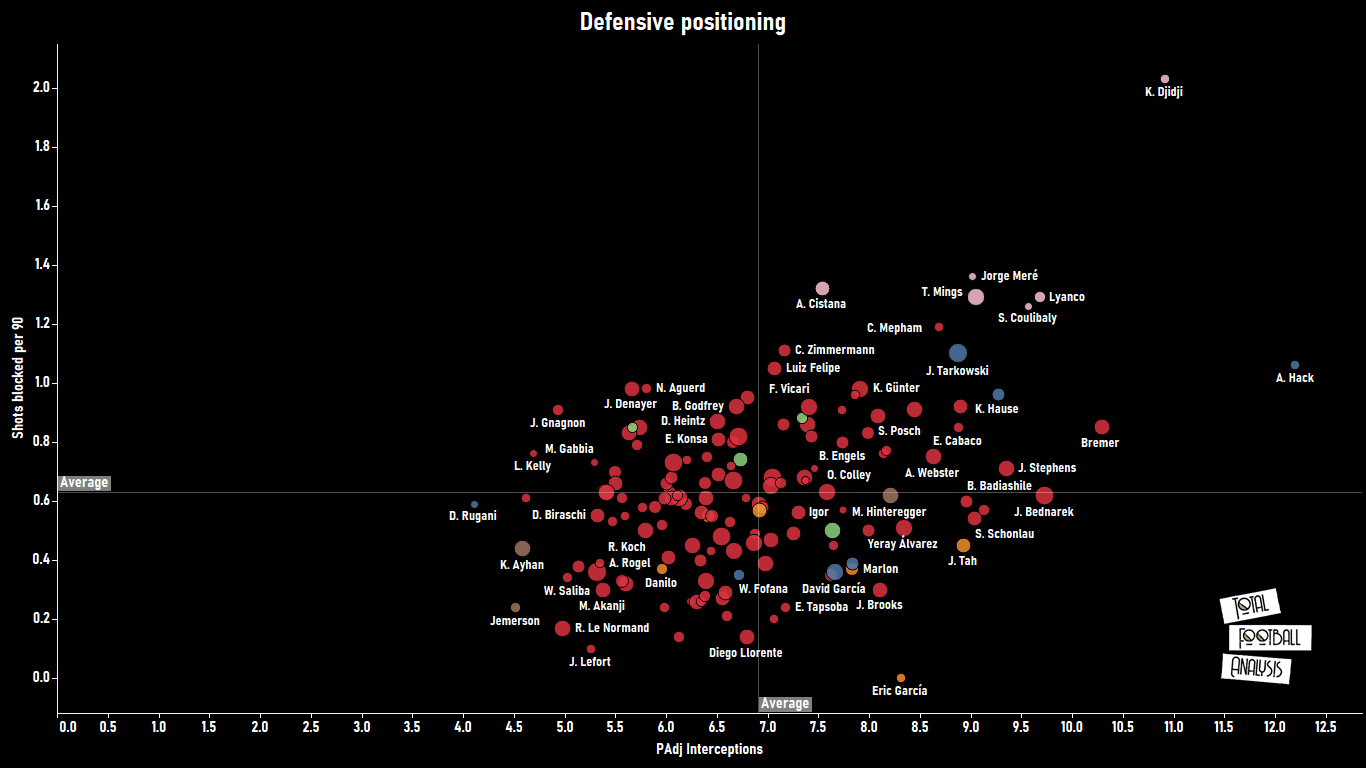
Next up, we will look at the positioning of the centre-backs. To do so, we will be looking at two metrics which are the possession-adjusted interceptions per 90 and the shots blocked per 90. Understandably, shots blocked would be directly related to the volume of defending that the players would have to do. However, Southampton’s set-up could see them pushed to the back foot and hence such defenders would be good to have.
We immediately see standouts in Djidji and Hack who had featured earlier as well. The former is the best overall with 10.91 PAdj interceptions and 2.03 shots blocked per 90 in his 932 minutes last season. Hack has the highest PAdj interceptions with 12.20 and above-average shots blocked per 90 of 1.06 in his 853 minutes. Apart from them, we see FC Köln’s Jorge Meré (9.02 PAdj Interceptions and 1.36 shots blocked), Torino’s Lyanco (9.68 PAdj interceptions and 1.29 shots blocked) and Dijon’s Senou Coulibaly (9.57 PAdj interceptions and 1.26 shots blocked per 90) all feature highly despite their lower minutes in their respective squads this season.
The remaining two players who have considerable statistics are Aston Villa’s Tyrone Mings (9.05 PAdj interceptions and 1.29 shots blocked per 90) and Brescia’s Andrea Cistana (7.54 PAdj interceptions and 1.32 shots blocked). The two have played considerable minutes for their sides and Cistana is yet to enter his peak age range as well. We also see that the likes of Tarkowski and Hause have decent statistics in addition to the others highlighted.
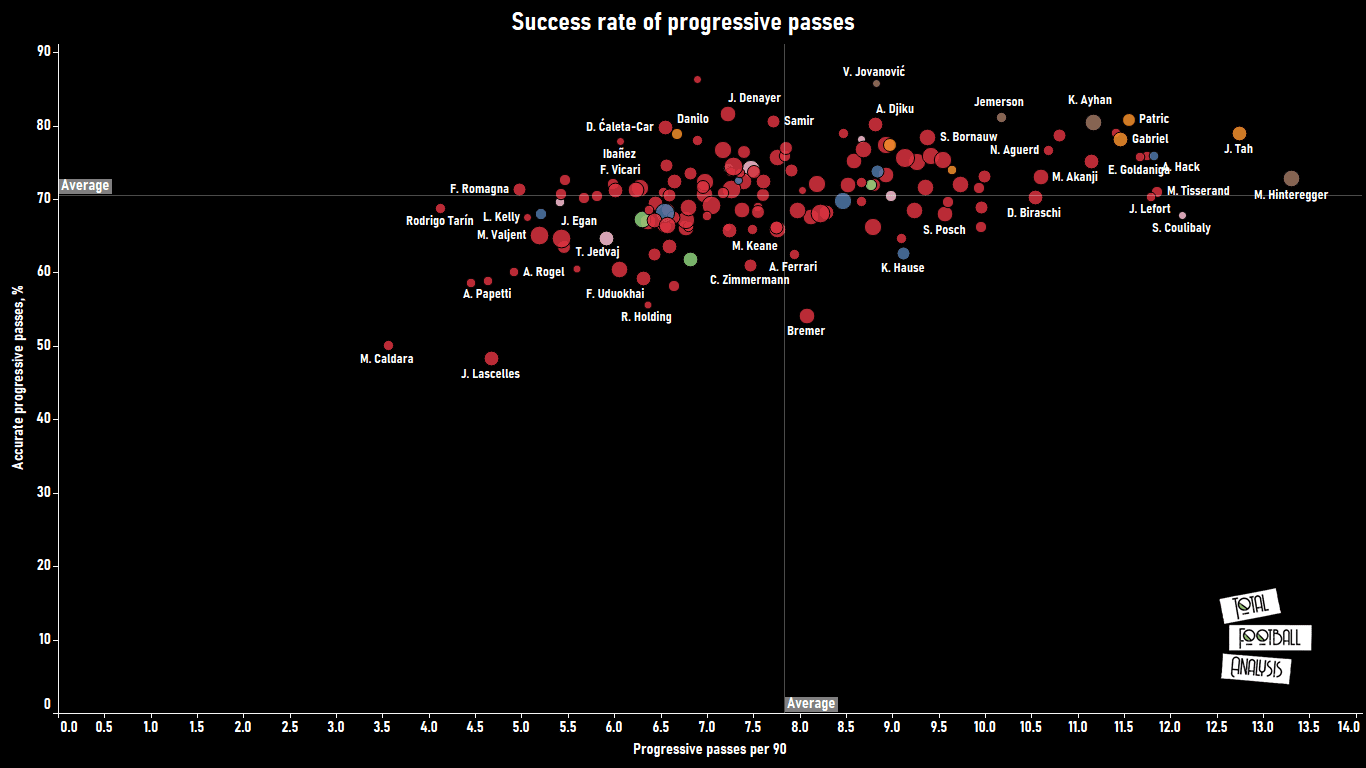
As we saw earlier in our analysis, the Southampton defenders would be required to have good passing statistics owing to the style of play. While centre-backs usually make a good number of lateral and back passes, we intend to find players who are good with their forward passes and more importantly their ability to progress their team up the pitch. Defenders with good progressive passing statistics are usually comfortable on the ball and this would be very useful for Southampton.
Looking at the data, we will focus our analysis on those players with brown markings first. Those with the orange markings feature well in their final third passing as well and hence will be covered in the next part of our analysis. Martin Hinteregger is the clear leader in terms of progressive passes per 90 with his value of 13.31 being a fair way ahead of the rest. In terms of success rate, Vukašin Jovanović has impressed with his success rate of 85.27% after 8.83 progressive passes per 90 being the highest among those defenders who fall above the average lines. The Serbian, however, has played just 642 minutes for Bordeaux last season.
The remaining two players have had a good amount of passes made along with a relatively higher success rate and they are Monaco’s Jemerson (10.18 progressive passes per 90 and 81.10% success rate) and Fortuna Düsseldorf’s Kaan Ayhan (11.17 progressive passes per 90 and 80.39% success rate). The latter has played 2876 minutes last season and this is nearly double that of Jemerson’s 1123 minutes last season. It should also be noted that Ayhan is capable of playing as a right-back as well and this could be a reason for his higher statistics.
The other players with impressive statistics will be covered in the next part although it is interesting to note that once again, Hack features well in this metric as well while Coulibaly has an impressive number of progressive passes per 90 although he falls below average in terms of accuracy.
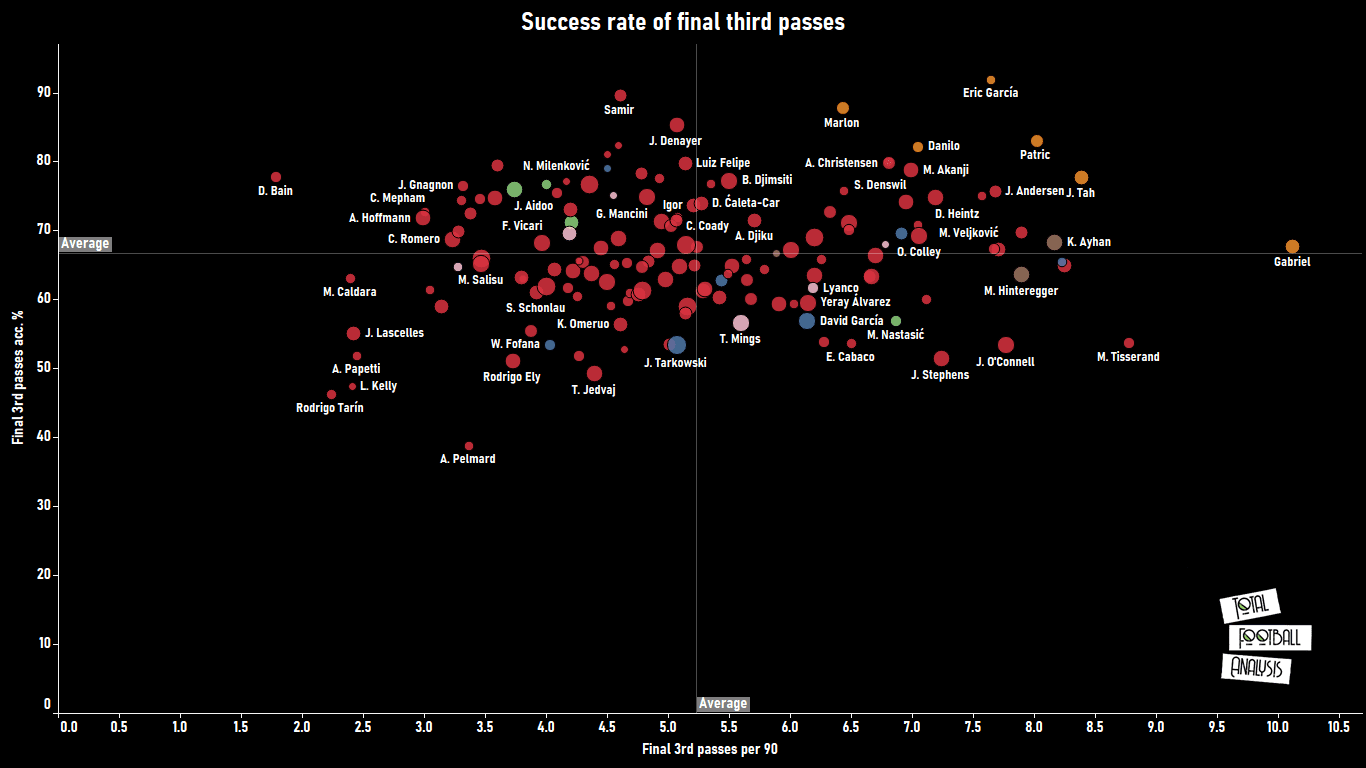
In the previous section of our analysis, we looked at how effectively the defenders could progress the ball up the pitch. However, with Southampton playing with a high backline, we should also look at the ability of the centre-backs to play passes to the final third. The Saints look to pack their front line and hence, the centre-backs should be capable of bypassing the midfield and play passes straight to the attackers. This would also prevent the Southampton midfielders from moving too far up in order to support the attack all the time and they can provide better support to the centre-backs as well.
We see the Lille player Gabriel lead the way with his 10.12 final third passes per 90 albeit with a lower success rate of 67.6%. The Brazilian has been linked with moves to Arsenal and Manchester United but considering his market value, Southampton could look to enter the race as well. Sassuolo’s Marlon and Manchester City’s Eric García rank highest in terms of their accuracy with 87.77% and 91.78% respectively. The former made slightly lesser final third passes per 90 with 6.43 passes while the latter made 7.65. García has also been linked with a move to Barcelona who are also looking to boost their backline and it would take a mammoth offer if Southampton should join the race for the 19-year-old.
The three other players with considerable statistics are Lazio’s Patric, Nice’s Danilo and Bayer Leverkusen’s Jonathan Tah. Patric (8.02 final third passes per 90 and 83.02% accuracy) also operates as a right-back and this could be a reason for his higher statistics. Danilo (7.05 final third passes per 90 and 82.11% accuracy) is also not a natural centre-back and can play in defensive midfield as well. Tah (8.39 final third passes per 90 and 77.67% accuracy), however, is a natural centre-back and at 24-years-old, is just entering his peak age. He has been linked with moves to a few big-name clubs and this would be a bother for Southampton who would have to do a lot of convincing in order to sign him.
We also once again see Ayhan featuring with decent statistics and yet again we see Hack perform well, though his accuracy falls just below the average line.

In the last part of our data analysis, we will look at the statistics for fouls per 90. Because Southampton play with such a high backline, they should not be looking to sign players that would give away silly fouls. Any rash challenge would almost definitely be a yellow card, if not red, considering that the centre-backs would most of the times be facing quick counters and are effectively the last men preventing the attacker from running through on goal. While we agree that defender are prone to giving away a greater number of fouls, if a player regularly picks up cards and ends up suspended, his output is reduced and hence we will look to omit players with high fouls per 90 statistics.
Owing to the above, our goal is to check that the standout players mentioned earlier do not give away too many fouls per 90. We see that Verona’s Paweł Dawidowicz has the highest fouls per 90 with 2.38 and he is followed by Roma’s Gianluca Mancini (2.07) and Kumbulla (2.00). We saw earlier that Kumbulla made the highest number of defensive duels per 90 as compared to the others and this could be a reason as to why he ends up with more fouls. Nevertheless, it is an important factor to consider.
The other players that we saw earlier do not feature too highly in this list and hence we may proceed to choose our final shortlist.
Conclusion
After going through the different statistics in our data analysis, our final shortlist is given below.
Alexander Hack
The 26-year-old is just about within the preferred age range of Southampton and it is impossible to omit him from this discussion. He has been one of the top performers in nearly all the statistics and going by the data alone, seems like a good fit in the current Southampton side. What is even more surprising is his current market value of just one million euros and we believe that at this price, he is definitely a player that Southampton could take a chance on.
Koffi Djidji
While the 27-year-old Torino centre-back ranked much lower in his passing statistics, he was a clear standout in terms of his positioning and had a good amount of defensive duels as well. Djidji still has a couple of years left of his peak range and with his market value of just about three million euros, is certainly someone that Southampton could afford to gamble on.
Martin Hinteregger
Southampton have already been linked with the Austrian centre-back and it is understandable why. Hinteregger excels in his passing statistics and it is clear that the Saints are in the market for a centre-back comfortable with forward passing. At 27, he still has at least two years left of his peak and with his experience, he would still be a good signing at his market value of 14 million euros.
Gabriel
The 22-year-old has caught the eye of Manchester United and Arsenal with his ball-playing ability and rumours of a 30 million euro bid have been circulating already. Everton have also apparently cooled off their interest but if Southampton could convince the Brazilian to join their side, there is no doubt he would be an exciting signing. It would, however, understandably be difficult to prize Gabriel away from the relatively bigger clubs.
Jonathan Tah
The Bayer Leverkusen centre-back has long been seen as a bright prospect in Germany and has just entered his peak age range as well. At 24, Tah has also been linked with moves to top sides but nothing concrete seems to have emerged. With a market value of 24 million euros, Southampton would have to offer more than they have in recent years in order to land his signing but should they pull it off, it would be a massive signing. The Saints would want to push for the European places and with Tah’s experience of playing European football, it would be interesting to see him develop even more at Southampton.
While we may have omitted other players with good statistics, we believe the above-mentioned players would offer Southampton the best in terms of their overall output. The Saints need a solid backline and if they spend wisely this summer, there is no doubt that they could push for a European place by the end of the 2020/21 season.

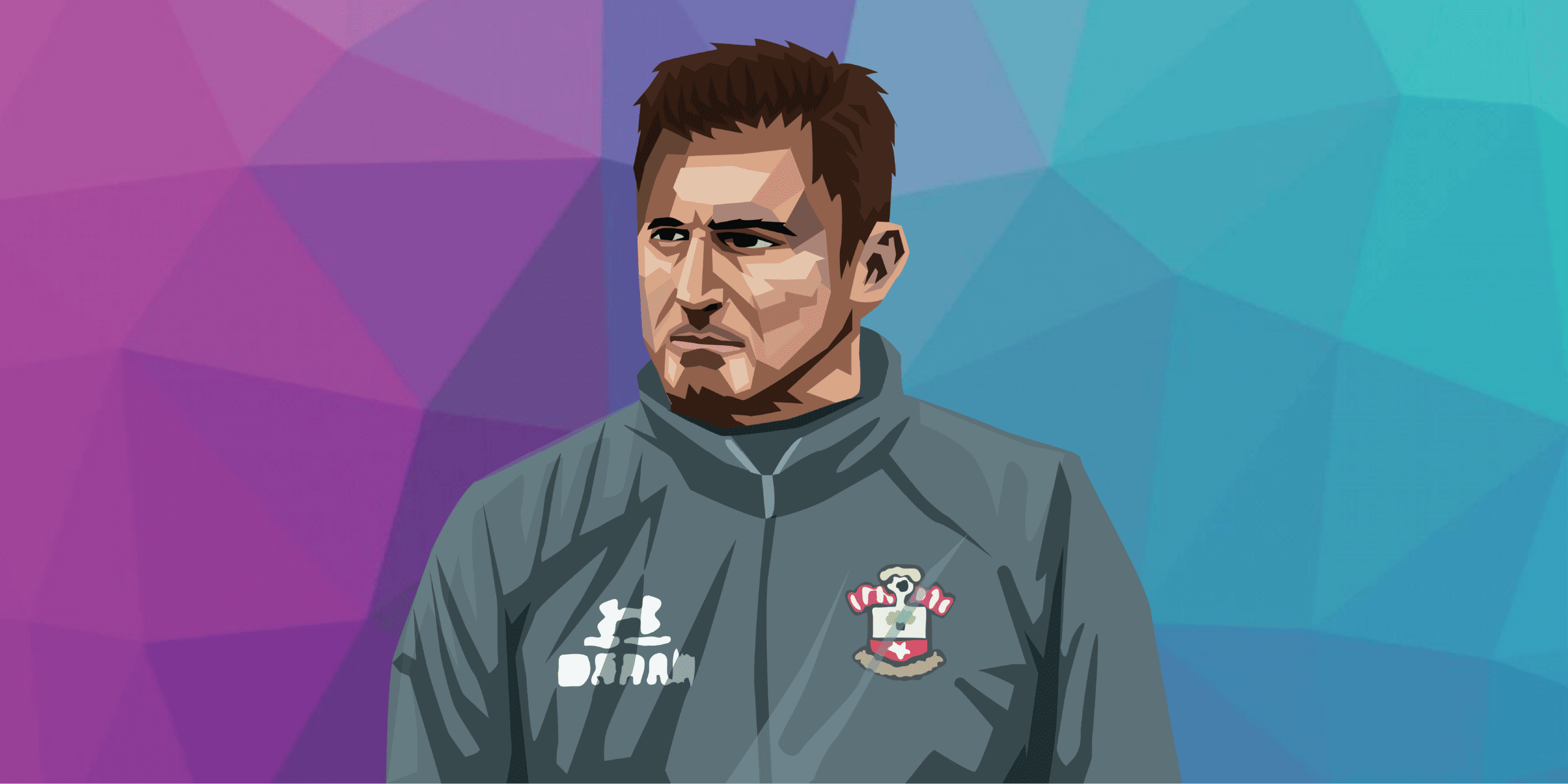



Comments